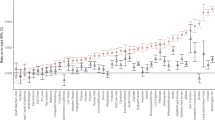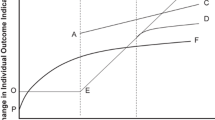Abstract
This paper examines how household social interaction affects housing and location demand in urban settings. The extended Alonso-Muth urban household model shows that the effects on density and location hinge upon the demand relationship between social activities and housing consumption. Stronger tastes for social activities outside the home lead to lower housing demand and decrease demanded distance from the CBD. Stronger tastes for socializing at home have the opposite effects on housing and location demands. The empirical analysis of interaction survey data yields results consistent with the theoretical framework.



Similar content being viewed by others
Notes
Access to the unrestricted data can be found through www.roper.uconn.edu.
Blacks and Hispanics account for 500 respondents each which resulted in an additional 288 blacks and 294 Hispanics to be included in the sample than otherwise would have been.
References
Alonso, W. (1964). Location and land use. Cambridge: Harvard University Press.
Brueckner, J.K., & Largey, A.G. (2008). Social interaction and urban sprawl. Journal of Urban Economics, 64, 18–34.
Caruso, G., Peeters, D., Cavailhes, J., Rounsevell, M. (2007). Spatial configurations in a periurban city. A cellular automata-based microeconomic model. Regional Science and Urban Economics, 37, 542–567.
DeSalvo, J.S. (1977). Urban household behavior in a model of completely centralized employment. Journal of Urban Economics, 4(1), 1–14.
Gaspar, J., & Glaeser, E. L. (1998). Information technology and the future of cities. Journal of Urban Economics, 43(1), 136–156.
Glaeser, E.L., & Gottlieb, J.D. (2006). Urban resurgence and the consumer city. Urban Studies, 43(8), 1275–1299.
Helsley, R.W., & Zenou, Y. (2011). Social networks and interactions in cities. IZA Discussion Paper, No. 5506.
Jacobs, J. (1961). The death and life of great American cities. New York: Vintage Books.
Kain, J.F. (1968). Housing segregation, negro employment, and metropolitan decentralization. Quarterly Journal of Economics, 82(2), 175–197.
Kim, J.S., Patacchini, E., Picard, P.M., Zenou, Y. (2017). Urban interactions. CEPR Discussion Paper, No. DP12432. Available at SSRN: https://ssrn.com/abstract=3071064.
Mills, E.S. (1967). An aggregative model of resource allocation in a metropolitan area. American Economic Review, 57(2), 197–210.
Mossay, P., & Picard, P.M. (2011). On spatial equilibria in a social interaction model. Journal of Economic Theory, 146, 2455–2477.
Muth, R.F. (1969). Cities and housing. Chicago: University of Chicago Press.
Picard, P.M., & Mossay, P. (2013). Spatial segregation and urban structure. CREA Discussion Paper Series 13-03, Center for Research in Economic Analysis, University of Luxembourg.
Turnbull, G.K. (1995). Urban consumer theory. Washington: Urban Institute Press.
Zenou, Y. (2011). Spatial versus social mismatch: the strength of weak ties. CEPR Discussion Paper, No. DP8244.
Acknowledgements
The authors would like to thank participants at the American Real Estate and Urban Economics Association and Western Economic Association International annual meetings. We also thank an anonymous referee for excellent suggestions. All remaining errors are our own.
Author information
Authors and Affiliations
Corresponding author
Rights and permissions
About this article
Cite this article
Hawley, Z.B., Turnbull, G.K. Social Interaction and Urban Location Decisions. J Real Estate Finan Econ 59, 1–26 (2019). https://doi.org/10.1007/s11146-018-9673-0
Published:
Issue Date:
DOI: https://doi.org/10.1007/s11146-018-9673-0




